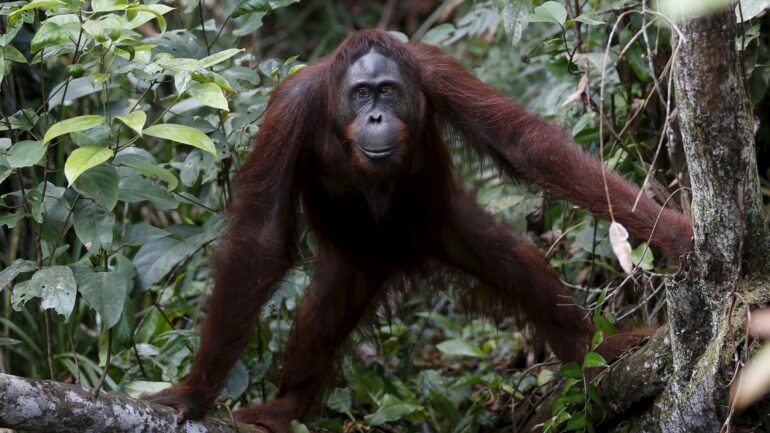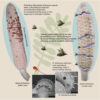Great apes deliberately spin themselves in order make themselves dizzy, academics at the University of Warwick and the University of Birmingham have discovered.
The findings could provide clues about the role of altered mental states for origins of the human mind.
Dr. Adriano Lameira, Associate Professor of Psychology at The University of Warwick who co-led the study said, “Every culture has found a way of evading reality through dedicated and special rituals, practices, or ceremonies. This human trait of seeking altered states is so universal, historically, and culturally, that it raises the intriguing possibility that this is something that has been potentially inherited from our evolutionary ancestors.”
“If this was indeed the case, it would carry huge consequences on how we think about modern human cognition capacities and emotional needs.”
The research team came across a viral video of a male gorilla spinning in a pool, and as they continued researching YouTube, came across more videos of gorillas, chimpanzees, bonobos, and orangutans all engaging in spinning behaviors.
Through analyzing over 40 online videos, the researchers found that on average the primates revolved 5.5 times per episode of spinning, with the average speed 1.5 revolutions per second and the primates did this on average three times.
Researchers compared great ape spinning speeds and found that they can spin while holding on a rope as fast as professional human dancers and circus artists, as well as Dervish Muslims who take part in whirling ceremonies to achieve a spiritual trance.
Dr. Lameira explained, “Spinning alters our state of consciousness, it messes up with our body-mind responsiveness and coordination, which make us feel sick, lightheaded, and even elated as in the case on children playing in merry-go-rounds, spinner-wheels, and carousels.”
“What we wanted to try to understand through this study is whether spinning can be studied as a primordial behavior that human ancestors would have been able to autonomously engage in and tap into other states of consciousness. If all great apes seek dizziness, then our ancestors are also highly likely to have done so. ”
“We asked ourselves what role these behaviors play when it comes to the origins of the human mind.”
“The apes were doing this purposefully, almost as if they were dancing—a known mechanism in humans that universally facilitates mood regulation, social bonding and heightens the senses and is based on rotation movements. The parallel between what the apes were doing and what humans do was beyond coincidental.”
In many of the videos, the primates were using ropes or vines to spin, and it was in these videos where they were spinning the fastest and for the longest amounts of time.
The research team analyzed the videos and compared it to videos of purposeful human pirouettes, for example, ballet dancing, traditional Hopak dancing, whirling dervishes and aerial silks performances.
The team then self-experimented spinning at these speeds and times and found it difficult to achieve the third bout of spins at these speeds, as great apes did. Apes were noticeably dizzy at that point in the videos, and they were likely to lose their balance and fall down.
“This would indicate that the primates deliberately keep spinning, despite starting to feel the effects of dizziness, until they are unable to keep their balance any longer,” explained Dr. Marcus Perlman, Lecturer at the Department of English Language and Linguistics of The University of Birmingham who co-led of the research.
Previous studies which attempted to understand human motivation for self-inducing dizziness focused on substance use such as alcohol or drugs, but it is uncertain whether these or other substances would have been accessible to human ancestors, either because those substances were not available in their environment or because individuals and communities didn’t have the technical and cultural knowledge to produce or process psychoactive substances.
Scientists say this new study could be more relevant to explain the role of altered states on the evolution of the human mind.
“The further back in human history you look, the less certain we can be about the role that substance-induced experiences played in our evolution. It’s not clear whether our ancestors had access to mind altering substances, or if they had the tools and knowledge to create the substance. ”
“For example, people may have had access to grapes, but you cannot assume they have the tools or the knowledge to create wine,” Dr. Lameira explained.
Scientists say that further research is needed to understand primates’ motivations for engaging in these behaviors, to understand why our own ancestors might also have been driven to seek out these spinning and mind-altering experiences.
Dr. Lameira adds, “There could be a link to mental health here, as the primates we observed engaging in this behavior were mostly captive individuals, who may be bored and trying to stimulate their senses in some way.”
“But it could also be a play behavior. If you think about a child’s playground, almost all the playground apparatus—swings, slides, seesaws and roundabouts or merry-go-rounds—they are all designed to challenge your balance or disrupt the body-mind responses.”
“There are some interesting parallels that should be investigated further, in order to understand why people are motivated to engage in these behaviors. It could very well be that we have been seeking and engaging in mind-altering experiences before we were even modern humans.”
The paper is published in Primates.
More information:
Adriano Lameira et al, Great apes reach momentary altered mental states by spinning, Primates (2023). DOI: 10.1007/s10329-023-01056-x
Provided by
University of Birmingham
Citation:
Dizzy apes provide clues on human need for mind altering experiences (2023, March 13)



